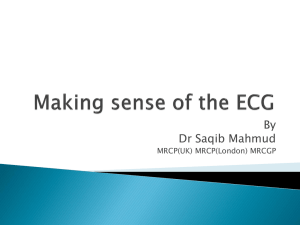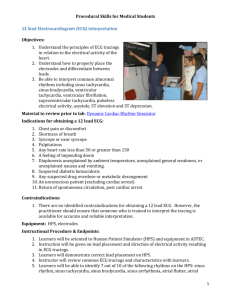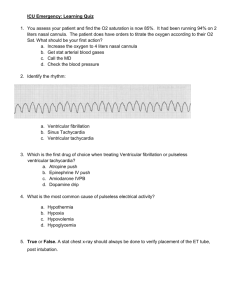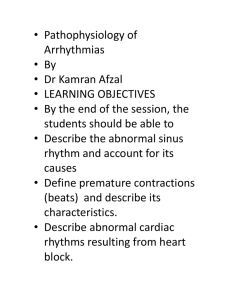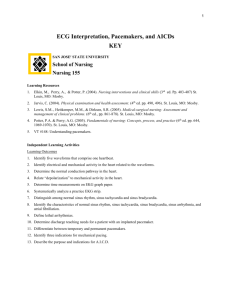pubdoc_12_6528_773
advertisement
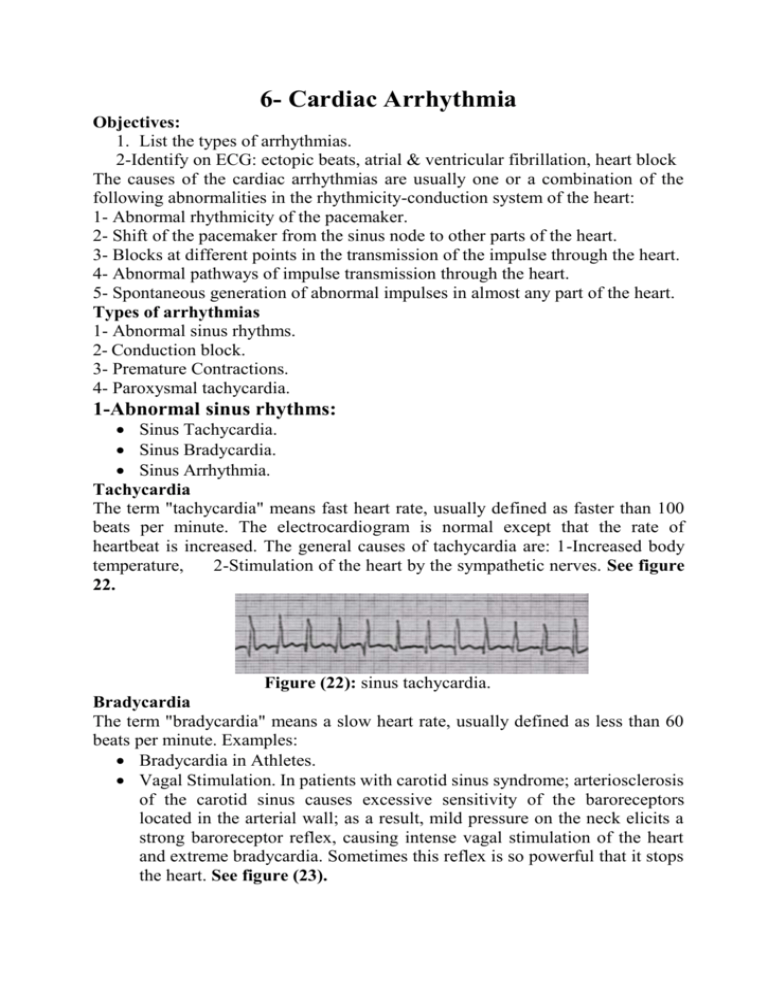
6- Cardiac Arrhythmia Objectives: 1. List the types of arrhythmias. 2-Identify on ECG: ectopic beats, atrial & ventricular fibrillation, heart block The causes of the cardiac arrhythmias are usually one or a combination of the following abnormalities in the rhythmicity-conduction system of the heart: 1- Abnormal rhythmicity of the pacemaker. 2- Shift of the pacemaker from the sinus node to other parts of the heart. 3- Blocks at different points in the transmission of the impulse through the heart. 4- Abnormal pathways of impulse transmission through the heart. 5- Spontaneous generation of abnormal impulses in almost any part of the heart. Types of arrhythmias 1- Abnormal sinus rhythms. 2- Conduction block. 3- Premature Contractions. 4- Paroxysmal tachycardia. 1-Abnormal sinus rhythms: Sinus Tachycardia. Sinus Bradycardia. Sinus Arrhythmia. Tachycardia The term "tachycardia" means fast heart rate, usually defined as faster than 100 beats per minute. The electrocardiogram is normal except that the rate of heartbeat is increased. The general causes of tachycardia are: 1-Increased body temperature, 2-Stimulation of the heart by the sympathetic nerves. See figure 22. Figure (22): sinus tachycardia. Bradycardia The term "bradycardia" means a slow heart rate, usually defined as less than 60 beats per minute. Examples: Bradycardia in Athletes. Vagal Stimulation. In patients with carotid sinus syndrome; arteriosclerosis of the carotid sinus causes excessive sensitivity of the baroreceptors located in the arterial wall; as a result, mild pressure on the neck elicits a strong baroreceptor reflex, causing intense vagal stimulation of the heart and extreme bradycardia. Sometimes this reflex is so powerful that it stops the heart. See figure (23). Figure (23): Sinus bradycardia (Guyton & Hall 2006). Sinus Arrhythmia The heart rate is increased during inspiration and decreased during expiration. The ECG is normal except that the number of the cycles varies with the two phases of respiration. See figure (24). Figure (24): Sinus arrhythmia. 2-Conduction block: Sinoatrial Block. Atrioventricular Block (Heart Block). 1. First Degree Heart Block. 2. Second Degree Heart Block. 3. Third Degree Heart Block. Sinoatrial Block The impulse from the sinus node is blocked before it enters the atrial muscle. There is missed beat. Figure 25. Figure (25): Sinoatrial nodal block (missed beat). Atrioventricular block (Heart Block): Heart block is caused by abnormality of impulse conduction in the AV node. The causes of block are: 1- Ischemia of the A-V node by coronary insufficiency. 2- Compression of the A-V node by scar tissue or by calcification. 3- Inflammation of the A-V node, such as occur in rheumatic fever. 4- Extreme stimulation of the heart by the vagus nerves. There are three types: A- First degree: Prolonged P-R interval, The normal time between the beginning of the P wave and the beginning of the QRS complex is 0.12 – 0.21 second. When the P-R interval increases above 0.21 second, the P-R interval is said to be prolonged and the patient is said to have first degree incomplete heart block. B- Second degree: there are dropped beats of the ventricles. This condition is called second degree incomplete heart block, one dropped beat as a result of failure of conduction from the atria to the ventricles. C- Third degree (Complete heart block): Conduction from the atria to the ventricle is completely interrupted. Ventricular beats are independently of the atrial beats. Ventricular rhythm is approximately 40 – 60 beats/ minute. It is associated with bradycardia. Figure (26). Figure (26): Atrioventricular (AV) node block (Fox, 2006). In some patients with A-V block, suddenly no impulses are conducted from the atria into ventricles for a period of time. The ventricles usually stop for 5 to 30 seconds. Because brain can not remain active for more than 4 to 5 seconds without blood supply, most patients faint a few seconds after complete block occurs. This period of fainting is known as the Stokes-Adams syndrome. 3-Premature Contractions: A premature contraction is a contraction of the heart before the time that normal contraction would have been expected. This condition is also called extrasystole, premature beat, or ectopic beat. Most premature contractions result from ectopic foci in the heart, The possible causes: Local areas of ischemia. Small calcified plaques at different points in the heart. Toxic irritation of the A-V node, Purkinje system, or myocardium caused by drugs, nicotine, or caffeine. Mechanical initiation during cardiac catheterization. Premature Atrial Contractions The P-wave of this beat occurs too soon in the heart cycle, and the P-R interval is shortened, Also, the interval between the premature contraction and the next succeeding contraction is slightly prolonged, which is called a compensatory pause. Premature atrial contractions occur: In healthy people. In athletes. Mild toxic conditions resulting from; excess smoking, lack of sleep, ingestion of too much coffee, alcoholism, and the use of various drugs. Figure 27. Figure (27): Atrial premature beat. Premature Ventricular Contractions Premature ventricular contractions (PVCs) cause specific effects in the electrocardiogram, The QRS complex is usually prolonged. The QRS complex has a high voltage. The T wave has a potential polarity opposite to that of the QRS complex. Some PVCs result from factors such as cigarettes, coffee, lack of sleep, and emotional irritability. Other PVCs originate from infracted or ischemic areas of the heart. Figure 28. Figure (28): Ventricular ectopic beats, 4-Paroxysmal tachycardia: The term "paroxysmal" means that the heart rate usually becomes rapid in paroxysms, beginning suddenly and lasting for a few seconds, a few minutes, a few hours, or much longer. Then the paroxysms usually end suddenly as they begun. This phenomenon could be explained according to Reentry phenomenon in that the impulse passes in one direction to excite the cardiac muscle fibers, but if the impulse returns high up, it excites the cardiac muscle fibers again. Supra ventricular paroxysmal tachycardia: There is normal QRS complex, T wave but missing P wave. there is a sudden increase in the rate of heartbeat from about 95 to about 150 beats per minute. A- Ventricular paroxysmal tachycardia: It is a series of ventricular premature beats one after another without any normal beat. It is a serious condition because it may change to ventricular fibrillation. See figure29. Figure (29): Two types of paroxysmal tachycardia (Ganong's review of medical physiology 20100) 5- Flutter and fibrillation: 1-Atrial flutter: The rate of contraction of atria 200-350 beat /minute, so the amount of blood pumped by atria is slight. ECG show high rate of P wave, QRS is less than P wave number, not all impulse pass AV node, so P: QRS is 2:1 or 3:1. 2-Atrial fibrillation: There is loss of systolic activity of atria but as 70% of the blood passes from atria to ventricle passively. The patient will not be affected during rest and the effect will appear during exercise where 30% of active systole will be used. ECG show very rapid low voltage P wave (350-600 P wave/minute). QRS normal in component, irregular and rapid (125-150 QRS/minute). See figure 30. Figure (30): Atrial flutter and fibrillation (Ganong's review of medical physiology 2010). 3-Ventricular fibrillation: It seems to be produced by discharge of one or more ectopic foci. The ventricle losses its contractile ability. It is very dangerous, death can occur few minute after its occurrence. A strong high voltage electric current (110 – 1000) volts (DC shock) passed through the ventricles for short interval can stop fibrillation in which all action potential stop, and the heart remains quiescent for 3 to 5 second, after which it begin to beat again. See figure 31. Figure (31): Ventricular fibrillation & DC shock (Guyton & Hall 2006). 6-Effect of potassium concentration of blood on ECG: Hyperkalemia is very dangerous, lethal because its effect on heart. Change in ECG is tall peaked T wave. As plasma K level raises, paralysis of atria and prolongation of QRS complex waves occur. The rest- membrane potential of muscle fibers decreases as the extra cellular K concentration increase. The fiber becomes unexcitable, heart stops in diastole. A decrease in the plasma K level causes prolongation of PR interval, prominent U wave, T wave inversion. Hypokalemia is a serious condition but it is not as rapidly fatal as hyperkalemia. Figure (32). Figure (32): Effect of Hyperkalemia and hypokalemia on ECG (Ganong's review of medical physiology 2010). 7-Ischemic heart disease: Myocardial ischemia may be detected by changes in the S-T segment of the electrocardiogram. See figure 33. Figure (33): Ischemic heart


